14 results
Murals
Walls of Slavery, Walls of Freedom
This is first major collection of murals focused on resistance, empowerment and slavery. It currently brings together murals from the United States from the 1920s to present day, with a large focus on murals depicting historical slavery and antislavery. In this collection, we see the abolitionists and heroic figures of black history emerge from community walls as ancestors for 20th-century social justice leaders.
Creator: Hannah Jeffery
Project Director: Zoe Trodd
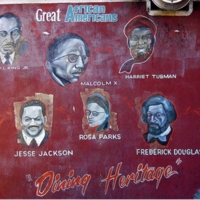
Great African Americans
An unknown artist painted this mural in Harlem, New York City, on the facade of Dining Heritage. It depicts the abolitionists Frederick Douglass and Harriet Tubman, as well as Martin Luther King Jr., Rosa Parks, Jesse Jackson and Malcolm X. It was destroyed in 2015.
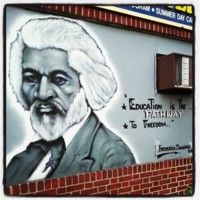
Educational Mural
This mural was painted in the Bronx, New York City by an unnamed artist and depicts Frederick Douglass in the later years of his life, and the phrase "Education is the pathway to freedom." it had been destroyed by 2016.
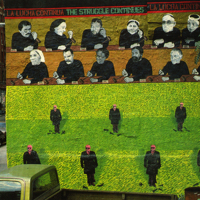
The Last Judgement
This mural, part of a wider series called La Lucha Continua/The Struggle Continues, is split into two halves. The bottom half shows anonymous arms merchants in suits, and the top portrait shows portraits of local residents alongside the leaders Nelson Mandela, Daniel Ortega, Robert F. Williams…
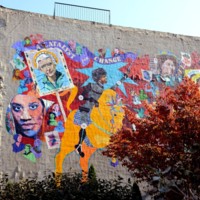
When Women Pursue Justice
In 2005, Artmakers Inc. created a large-scale political mural titled When Women Pursue Justice. During the genesis of the mural, it seemed like an overly ambitious project with little funding, and a heavy reliance on the generosity of its collaborators. Located in Brooklyn, at the busy intersection…
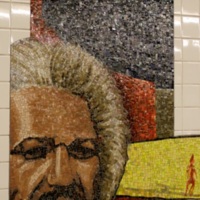
Migrations
In 1999, artist Christopher Wynter created a mosaic installation at the Cathedral Parkway subway station in Harlem. He explained that the 3-part mosaic series titled Migrations “present the ideas of uprooting, migration, and progress in symbolic form." The installation features Frederick Douglass…
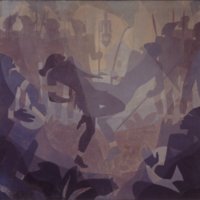
Aspects of Negro Life
Two years prior to the Texas Centennial Exposition, Aaron Douglas created a four-part mural series titled Aspects of Negro Life, to be housed in the 135th Street branch of the New York Public Library, the Schomburg Center. The various panels portray black history from slavery through to present. The…
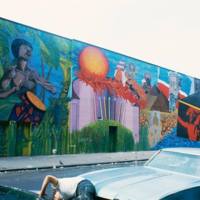
Afro Latin Coalition (Ghetto Ecstasy)
In 1973, Cityarts Workshop muralist James Jannuzzi painted a mural in New York City about Puerto Rican abolition, gang culture and black heritage. The mural includes a shirtless, muscular figure playing drums in a tropical landscape, Nubian symbols such as the ankh next to pyramids, and Ramón…
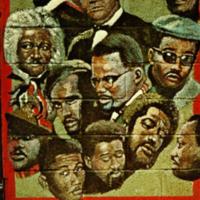
Nation of Islam
In 1990, this mural titled Nation of Islam at Charles Place in Brooklyn was created. The mural unites many radical figures of black history, including the antislavery leader Frederick Douglass, W.E.B. Du Bois, Elijah Muhammad, H. Rap Brown, Malcolm X, Marcus Garvey, Eldridge Cleaver and Bobby…
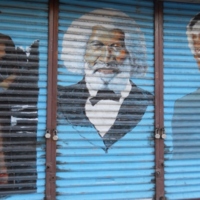
Tubman, Douglass, Mandela
This mural was created in 2008 by an unknown artist. Painted on a storefront on Ralph Avenue in Brooklyn, it depicted Harriet Tubman, Frederick Douglass and Nelson Mandela. As of 2014, it no longer existed.
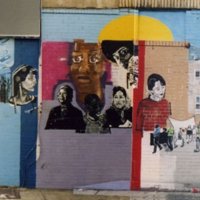
Women Warriors
In 2001, Brooklyn-based muralist Leola Bermanzohn created a mural in the Flatbush area of Brooklyn titled Women Warriors. Bermanzohn works as a muralist for the Groundswell organisation, launched in 1996 with the mission of bringing together artists, youth and community organisations to create…
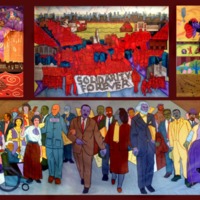
The City at the Crossroads of History
In 2011, the Puffin Foundation commissioned Mike Alewitz to paint a mural for the Puffin Gallery of Social Activism that would be on display in the Museum of the City of New York. Completed in 2014, the mural is a tribute to the labour and social justice movements and contains four panels. It…
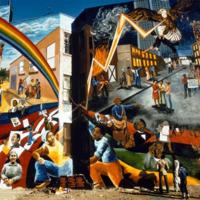
Douglass Street Mural
Mary Patten painted Douglass Street Mural – Cityarts Workshop’s first Brooklyn-based project – in 1976. Over a five-month period, Patten led a group of 20 teens and adults to develop various themes for the mural that would be located on Douglass Street in the Park Slope area of Brooklyn - an…
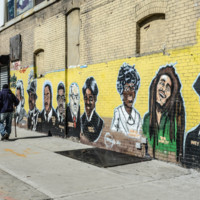
Bed-Stuy Mural
In 2009, the NYC Justice Corps created a mural on Nostrand Avenue and Herkimer Street in Bedford-Stuyvesant, Brooklyn. The NYC Justice Corps was created as part of the city’s strategy to combat poverty and has the mission to “develop the capacity of neighborhoods to address the reintegration…
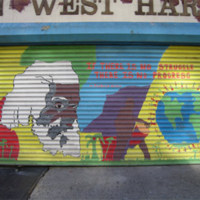
If There is No Struggle
This mural was painted by an anonymous artist around 2007 and no longer exists, but is an important example of both the ephemeral and guerrilla nature of murals: some last for short periods of time on buildings and streets in communities. This particular mural was created in West Harlem and focused…